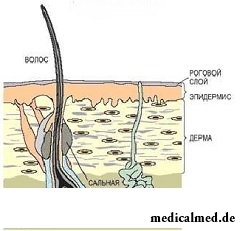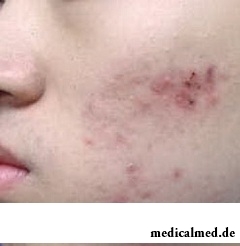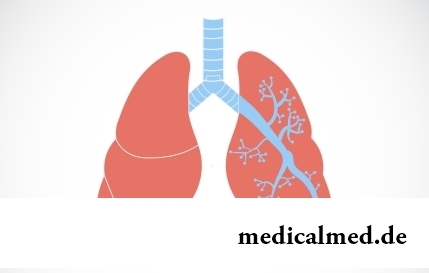





Sebaceous glands
Sebaceous glands – skin glands, whose secret is fatty lubricant for the surface of skin and hair.
They are located practically on all skin, except for soles of legs and skin of palms. By the sizes they significantly differ, and also have a different structure and localization in different sites of skin. Most of all accumulation of sebaceous glands is observed in a pilar part of the head, and also on a chin and cheeks. They are located and on the sites deprived of hair: in mouth corners, on lips, a clitoris, nipples, small vulvar lips, a balanus, a prepuce.
The arrangement, the sizes and structure of sebaceous glands depends on the term of laying of a hair. They are located in a reticular (mesh) layer of a derma and lie in a little slanting direction between a muscle-podnimatelem of a hair and its folliculomas. At reduction of a muscle of hair becomes straight and puts pressure, promoting secretion of a sebaceous gland.
The simple sebaceous gland consists of an output channel and a trailer secretory part. Vyvodnoy Canal is represented by not keratosic flat epithelium, and a trailer secretory part covered from within – the sack outside surrounded with a thin joint capsule. Under the capsule the rostkovy layer – the undifferentiated cells having high mitotic activity which lie on a basal membrane is located. In the center of a trailer secretory part there is a cellular detritis consisting of the broken-up secretory cells – gland secret.
Blood vessels provide blood supply of glands and feed root system of a hair. Sebaceous glands are supplied with adrenergic and cholinergic nerve fibrils. Adrenergic nerve fibrils probodat a basal membrane and surround secretory cells, and cholinergic nerve fibrils are located on a surface of a basal membrane.
Throughout all human life sebaceous glands change. At the time of birth they are very developed and intensively function. For the first year of life against the background of reduced secretion of sebaceous glands their growth prevails, further they partially atrophy, especially in skin of a back and shins.
During puberty their growth amplifies, increases function of sebaceous glands again.
At advanced age of gland cease to develop that is shown in reduction of their sizes, simplification of a structure, by decrease in functional and metabolic activity of secretory cells. Some glands in general disappear with age.
Normal gland in days allocates about 20 g of skin fat. Secretion of sebaceous glands does a hair elastic, regulates water evaporation, softens epidermis, interferes with penetration into skin of some substances from the outside, renders anti-fungal and antimicrobic effect.
Function of sebaceous glands is regulated in the neurohumoral way by preferential sex hormones which can sometimes cause strengthening of their activity (allocation of too large number of a secret, a hyperplasia). At newborn children hypophyseal maternal hormones and progesterone exert strong impact on glands, and during puberty activation of gonadotropic function of a front part of a hypophysis, strengthening of activity of gonads, activation of bark of adrenal glands acts on them.
Pathologies of sebaceous glands
Pathology of glands consists in malformations, dystrophic changes, functional disturbances, an inflammation of sebaceous glands and tumors of glands.
Dysfunction of sebaceous glands, as a rule, results from defeat vegetative peripheral or the central nervous system, disbolism and hormonal regulation. Often strengthening of activity of glands can be observed at a catatonic stupor, defeats of a front share of a hypophysis, gonads, bark of adrenal glands, and also at epidemic viral encephalitis owing to defeat of the vegetative centers. Leads depression of function of hemadens to depression of function of glands, for example, at an orkhiektomiya.
Often disturbance of work is resulted by obstruction of sebaceous glands. One of the most widespread pathologies which cornerstone disturbance of secretory function is is seborrhea. At this disease in channels of glands there are grease and horn traffic jams, or the comedones resulting from obstruction of sebaceous glands. Also frequent phenomenon is emergence of atheromas – retentsionny cysts. Multiple cysts arise also at a pilosebotsistomatoza owing to disturbance of a nevoid dysplasia of epidermis.
Dystrophic changes can be as age character, and to develop at some acquired diseases (a scleroderma, a skin atrophy, etc.). Often dystrophic changes are caused by hereditary factors.
The inflammation of sebaceous glands arises quite often, especially during puberty. The inflammation is characterized by formation of eels. At the same time inflammatory process can take walls of glands and fabric around them (pustular eels), and can extend also in deeper layers of skin, sometimes even taking hypodermic cellulose (flegmozny eels).
True adenoma of gland most of which often develops at adult and elderly people and looks as a dense round small knot on a back or a face belongs to benign tumors of sebaceous glands.
The bazalioma which has mestnodestruiruyushchy growth belongs to malignant tumors. Most often cancer of a sebaceous gland develops from cartilage glands a century – meibomian glands.
Except people, only one living being on the planet Earth – dogs suffers from prostatitis. Here really our most loyal friends.

Any of us is not insured from a heavy illness of the loved one. Happens and so that someone from family members becomes lying бо...
Section: Articles about health
Sugar - the digestible refined product which is not of special value for an organism of the modern person. The use of sugar in food is based rather on the psychological dependence caused by desire to indulge itself with something tasty, and in дальнейш...
Section: Articles about health
We present to yours the TOP of the medicamentous means exerting the stimulating impact on a potentiality, i.e. on ability of the man to commission of sexual intercourse. At once it is necessary to tell that not always disturbances of erectile function can be eliminated with reception of this or that drug. The reasons of decrease in a potentiality there can be a set, from banal overfatigue before tumoral process in a small basin therefore if the man faces similar problems too often, it should turn...
Section: Articles about health
Let's begin with the fact that a separate illness which is called "adjournment of salts", just does not exist. In practice this household name of plank beds...
Section: Articles about health
For the city dweller the fitness is the most convenient sport. It is enough to acquire the subscription to the gym to get access to various apparatuses and an opportunity to train under the leadership of the experienced consultant. Many consider fitness on...
Section: Articles about health
Olive oil – the product capable to make a powerful contribution to health of the person if it includes it in the diet. The rich vitamin composition of oil does it by a product number one from many diseases including from deadly. Only two tablespoons of oil from olives in day prevent emergence of diseases of vessels and heart, cancer, problems with digestion, presenilation, a depression and many other illnesses which treatment would demand a lot of time and forces. Let's consider on...
Section: Articles about health
Condition of lips (their morbidity, outward) – one of indicators of health of the person. Peeling, dryness, pallor, and also трещ...
Section: Articles about health
Maternal milk is the best food for the newborn. It is the unique natural product containing an optimum set of nutrients, and which is best adapted in order that the baby normally developed and it was protected from harmful fa...
Section: Articles about health
The healthy nutrition is the invariable principle of health and good health for long years of the woman. Nevertheless, in a diet at each stage of life there are the features allowing to support an organism by those substances which are most necessary for it at present. Eating according to them, the woman will be able to feel vigorous and strong, and also to adapt to changes in an organism so that they allowed it to lead active lifestyle at any age....
Section: Articles about health
Each failure in work of bodies and systems of a human body is, as a rule, shown by the whole complex of symptoms. In particular, N...
Section: Articles about health
"Epilepsy" doctors made the diagnosis in antique times. Displays of an illness and pattern of its development are very well studied. However for nonspecialists this disease remains to not less mysterious, than in the ancient time. Many delusions are connected with epilepsy...
Section: Articles about health
Partial and the more so full loss of hearing significantly reduces quality of life. Difficulties with communication lead to loneliness and isolation. The person who badly hears experiences difficulties with social and professional implementation, quite often has problems in private life....
Section: Articles about health
The thought that the mass of their body is too big at least once in life visits from 80 to 95% of women. Many...
Section: Articles about health
The concept "gluten" (differently, a gluten) combines group of the proteins which are a part of rye, barley and wheat. For most of people the use of the food stuffs containing a gluten not only is safe, but also it is very useful. Nevertheless, there is a number the myth...
Section: Articles about health
The list of stereotypes of which, apparently, all know strongly includes following: British surely eat porridge for breakfast. Perhaps, not all modern residents of Britain arrive quite so, but for those from them which continue to follow this tradition, it is possible to be glad sincerely: oat flakes are a product which regular use not only helps the person to keep force and beauty long. Porridge in a special way influences an organism, protecting it from seriousness...
Section: Articles about health
The nature does not stand stagnation and monotony. It is known that tissues of a human body atrophy if do not receive necessary loadings...
Section: Articles about health
At this plant there are a lot of names: tuberiferous sunflower, Jerusalem artichoke, solar root, earth pear. Contrary to popular belief, it is not an exotic plant at all. The wild girasol grows in a midland of Russia practically everywhere: at the edges of roads...
Section: Articles about health
The medicine promptly develops, and the fact that else quite recently it seemed by miracle can now. We are not surprised any more to the fact that people with artificial joints and extremities can play sports, organ transplantation became a routine, and the latest cancer medicine allowed to achieve reduction of mortality in tens of times. Miracles of plastic surgery thanks to which people in 60 years are in the flower of beauty and freshness, too not a sensation any more....
Section: Articles about health
The name of this disease precisely reflects the problem reason: it consists in the bra fastener pressure upon a certain zone...
Section: Articles about health
The phenomenon of the panic attack is known long ago, but the reasons of its emergence still are up to the end not found out. It is established that more than 30% of people at least once in life become the victims of very unpleasant phenomenon: without everyones on that the reasons they have a feeling of horror, with...
Section: Articles about health
When overcomes feeling of hunger, and an opportunity to have dinner fully is absent, having a snack − the meals, small on volume, stabilizing sugar level in blood comes to the rescue. The relation of nutritionists to having a snack more often negative, but only because as snack people choose the most caloric products with the increased amount of "bystry" carbohydrates: cookies, rolls, chips, candies. Nevertheless, the advantage of having a snack is obvious to weight loss: the person avoids strong feeling of hunger...
Section: Articles about health
Statistically, pathologies of a thyroid gland in the world more than 500 million people have. Failures in work of this body conduct to is heavy...
Section: Articles about health
Frosty air, fresh wind and easy snowball at most of Russians are associated with cheerfulness, health and cheerful entertainments on which our winter is so generous. But, unfortunately, cold season sometimes brings also troubles with health. It is not about a season...
Section: Articles about health
More than a half of the married couples which faced prostatitis – leave. The new broadcast "Female View of Prostatitis" will help to learn – whether you have or your relatives problems....
Section: Articles about health
For residents of the countries of Southeast Asia various algas are an obligatory component of a daily diet. Their priest...
Section: Articles about health
According to World Health Organization, every third inhabitant of Earth has excess weight, and every tenth has obesity. The reason of this phenomenon, according to specialists, roots in one not very comforting fact: most of people consume much...
Section: Articles about health
All diseases from nerves – in this joke a big element of truth, are said by doctors. Constant stresses lead to decrease in protective forces of an organism, and it becomes vulnerable for a set of diseases. It is wrong to think that the stress is a problem of the present. Life of people and hundred, and one thousand years ago also abounded with problems therefore need of a relaxation understood in ancient times – to some techniques more than one thousand years. The person needs knowledge of how it is possible to relax, this knowledge пригод...
Section: Articles about health
